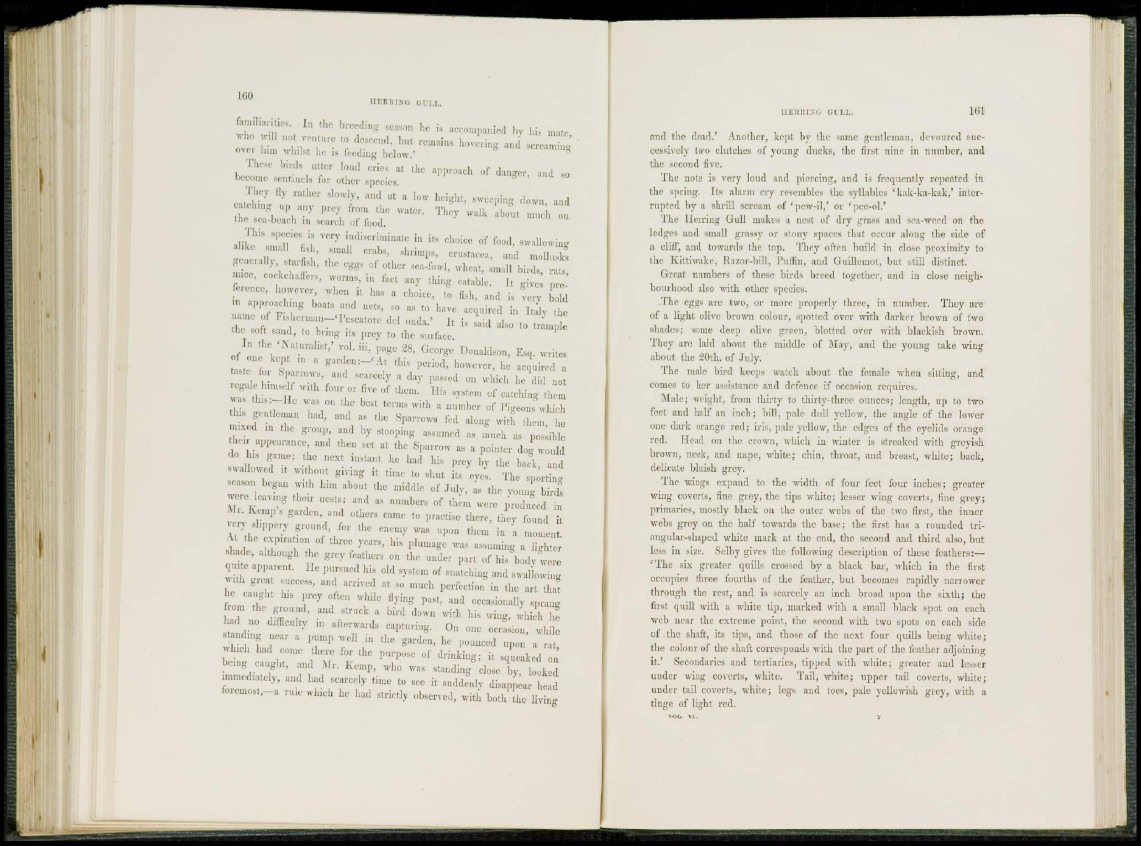
Hill
familiarities. In the breeding season he is accompanied by his mate,
who will not venture to descend, but remains hovering and screaming
over him whilst he is feeding below.'
These birds utter loud cries at the approach of danger, and so
become sentinels for other species.
They fly rather slowly, and at a low height, sweeping down, and
catching up any prey from the water. They walk about much on
the sea-beach in search of food.
This species is very indiscriminate in its choice of food, swallowing
alike small fish, small crabs, shrimps, crustacea, and mollusks
generally, starfish, the eggs of other sea-fowl, wheat, small birds, rats,
mice, cockchaffers, worms, in fact any thing eatable. Tt gives preference,
however, when it has a choice, to fish, and is very bold
in approaching boats and nets, so as to have acquired in Italy the
name of Fisherman—'Pescatore del onda.' It is said also to trample
the soft sand, to bring its prey to the surface.
I n the 'Naturalist,' vol. iii, page 28, George Donaldson, Esq. writes
of one kept in a garden:—'At this period, however, he acquired a
taste for Sparrows, and scarcely a day passed on which he did not
regale himself with four or five of them. His system of catching them
was this:—He was on the best terms with a number of Pigeons which
this gentleman had, and as the Sparrows fed along with them, he
mixed in the group, and by stooping assumed as much as possible
their appearance, and then set at the Sparrow as a pointer dog would
do his game; the next instant he had his prey by the back, and
swallowed it without giving it time to shut its eyes. The sporting
season began with him about the middle of July, as the young birds
were leaving their nests; and as numbers of them were produced in
.Mr. Kemp's garden, and others came to practise there, they found it
very slippery ground, for the enemy was upon them in a moment.
At the expiration of three years, his plumage was assuming a lighter
shade, although the grey leathers on the under part of his body were
quite apparent. He pursued his old system of snatching and swallowing
with great success, and arrived at so much perfection in the art that
he caught his prey often while living past, and occasionally sprang
from the ground, and struck a bird down with his wing, which he
had no difficulty in afterwards capturing. On one occasion, while
standing near a pump well in the garden, he pounced upon a rat,
which had come there for the purpose of drinking; it squeaked on
being caught, and Air. Kemp, who was standing close by, looked
immediately, and had scarcely time to see it suddenlv disappear head
foremost,—a rule which he had strictly observed, with both the living
and the dead.' Another, kept by the same gentleman, devoured successively
two clutches of young ducks, the first nine in number, and
the second five.
The note is very loud and piercing, and is frequently repeated in
the spring. Its alarm cry resembles the syllables 'kak-ka-kak,' interrupted
by a shrill scream of 'pew-il,' or 'pcc-ol.'
The Herring Gull makes a nest of dry grass and sea-weed on the
ledges and small grassy or stony spaces that occur along the side of
a cliff, and towards the top. They often build in close proximity to
the Kittiwake, Razor-bill, Puffin, and Guillemot, but still distinct.
Great numbers of these birds breed together, and in close neighbourhood
also with other species.
The eggs arc two, or more properly three, in number. They are
of a light olive brown colour, spotted over with darker brown of two
shades; some deep olive green, blotted over with blackish brown.
They arc laid about the middle of May, and the young take wing
about the 20th. of July.
The male bird keeps watch about the female when sitting, and
comes to her assistance and defence if occasion requires.
Male; weight, from thirty to thirty-three ounces; length, up to two
feet and half an inch; hill, pale dull yellow, the angle of the lower
one dark orange red; iris, p a l e yellow, the edges of the eyelids orange
red. Head on the crown, which in winter is streaked with greyish
brown, neck, and nape, white; chin, throat, and breast, white; back,
delicate bluish grey.
The wings expand to the width of four feet four inches; greater
wing coverts, fine grey, the tips white; lesser wing coverts, fine grey;
primaries, mostly black on the outer webs of the two first, the inner
webs grey on the half towards the base; the first has a rounded triangular
shaped white mark at the end, the second and third also, but
less in size. Sclby gives the following description of these feathers:—
' T h e six greater quills crossed by a black bar, which in the first
occupies three fourths of the feather, but becomes rapidly narrower
through the rest, and is scarcely an inch broad upon the sixth; the
first quill with a white tip, marked with a small black spot on each
web near the extreme point, the second with two spots on each side
of the shaft, its tips, and those of the next four quills being white;
the colour of the shaft corresponds with the part of the feather adjoining
it.' Secondaries and tertiaries, tipped with white; greater ami lesser
under wing coverts, white. Tail, white; upper tail coverts, white;
under tail coverts, white; legs and toes, pale yellowish grey, with a
tinge of light red.
VOL. VI. Y